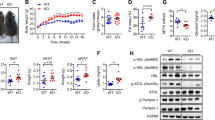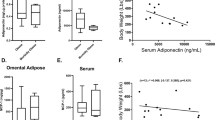Abstract
OBJECTIVE: To investigate the expression of eNOS and iNOS mRNA and protein in adipose tissue from subcutaneous (s.c.) and omental adipose tissue of obese subjects.
DESIGN: Subcutaneous and omental adipose tissue was obtained from subjects undergoing weight reduction surgery. Messenger RNA and protein levels were measured in tissue extracts and related to basal lipolysis, which was measured in isolated adipocytes from the same subjects.
SUBJECTS: Eight overweight but otherwise healthy male subjects (age 43.4±10.3 y, BMI 39±3.5 kg/m2, mean±s.e.m.).
MEASURESMENTS: For mRNA detection a competitive reverse transcription polymerase chain reaction method was used while protein was detected by Western blot. Glycerol release was determined in isolated adipocytes using a standard luminometric assay.
RESULTS: Tissue mRNA levels for eNOS in s.c. tissue were 6098±1969 amol/mg RNA and in omental tissue 6987±2914 amol/mg RNA (mean±s.e.m., P=0.75). iNOS mRNA levels were substantially lower; in s.c. tissue 227±127 amol/mg RNA and in omental tissue 245±162 amol/mg RNA (P=0.8). In Western blot, eNOS protein levels in s.c. and omental tissue were 1.88±2.0 and 7.47±4.11 (OD/mm2 100 µg total protein, P=0.0063), respectively. iNOS protein was expressed at significantly lower levels and barely detectable in both s.c. and omental tissue. Basal rate of lipolysis was two times higher in s.c. compared to omental fat cells (P=0.028).
CONCLUSIONS: eNOS protein is markedly increased in omental compared to s.c. adipose tissue in human obese subjects, probably due to post-transcriptional mechanisms. Since basal lipolysis is much lower in omental vs s.c. adipose tissue it is possible that regionally increased NO production, primarily by eNOS, may be involved in the site difference of basal lipolysis in obese subjects.
This is a preview of subscription content, access via your institution
Access options
Subscribe to this journal
Receive 12 print issues and online access
$259.00 per year
only $21.58 per issue
Buy this article
- Purchase on Springer Link
- Instant access to full article PDF
Prices may be subject to local taxes which are calculated during checkout

Similar content being viewed by others
References
Christopherson KS, Bredt DS . Perspectives series: nitric oxide and nitric oxide synthases J Clin Invest 1997 100: 2424–2429.
Michel T, Feron O . Nitric oxide synthases: which, how and why? J Clin Invest 1997 100: 2146–2152.
Ribière C, Jaubert AM, Gaudiot N, Sabourault D, Marcus ML, Boucher JL, Denis-Henriot D, Giudicelli Y . White adipose tissue nitric oxide synthase: a potential source for NO production Biochem Biophys Res Commun 1996 222: 706–712.
Andersson K, Gaudiot N, Ribière C, Elizalde M, Giudicelli Y, Arner P . A nitric oxide-mediated mechanism regulates lipolysis in human adipose tissue in vivo Br J Pharmac 1999 126: 1639–1645.
Elizalde M, Ryden M, van Harmelen V, Eneroth P, Gyllenhammar H, Holm C, Ramel S, Olund A, Arner P, Andersson K . Expression of nitric oxide synthases in subcutaneous adipose tissue of nonobese and obese humans J Lipid Res 2000 41: 1244–1251.
Gaudiot N, Jaubert A-M, Charbonnier E, Sabourault D, Lacasa D, Giudicelli Y, Ribière C . Modulation of white adipose tissue lipolysis by nitric oxide J Biol Chem 1998 273: 13475–13481.
Arner P . Regulation of lipolysis in fat cells Diabetes Rev 1996 4: 450–463.
Large V, Reynisdottir S, E1eborg L, van Harmelen V, Strommer L, Arner P . Lipolysis in human fat cells obtained under local and general anesthesia Int J Obes Relat Metab Disord 1997 21: 78–82.
Nadaud S, Bonnardeaux A, Lathrop M, Soubrier F . Gene structure, polymorphism and mapping of the human endothelial nitric oxide synthase gene Biochem Biophys Res Commun 1994 198: 1027–1033.
Xu W, Charles IG, Liu L, Moncada S, Emson P . Molecular cloning and structural organization of the human inducible nitric oxide synthase gene (NOS2) Biochem Biophys Res Commun 1996 219: 784–788.
Hall AV, Antoniou H, Wang Y, Cheung AH, Arbus AM, Olson SL, Lu WC, Kau CL, Marsden PA . Structural organization of the human neuronal nitric oxide synthase gene (NOS1) J Biol Chem 1994 269: 33082–33090.
Gross J, Müller I, Berndt C, Ungethüm U, Heldt J, Elizalde M, Peters LE, Andersson K . Quantitation of dopamine D2 receptor mRNA in a mesencephalic cell culture using a nonradioactive competitive reverse transcription polymerase chain reaction method J Neurosci Meth 1998 82: 187–194.
Reynisdottir S, Ellerfeldt K, Wahrenberg H, Lithell H, Arner P . Multiple lipolysis defects in the insulin resistance (metabolic) syndrome J Clin Invest 1994 93: 2590–2599.
Justice JM, Tanner MA, Myers PR . Endothelial cell regulation of nitric oxide production during hypoxia in coronary microvessels and epicardial arteries J Cell Physiol 2000 182: 359–365.
Acknowledgements
This study was supported by grants from the Swedish Medical Research Council, Swedish Diabetes Association, Swedish Heart and Lung Foundation, The Swedish Match Sverige AB, Karolinska Institute and the foundations of Novo Nordisk, A˚ke Wiberg and Stiftelsen fo¨r Vetenskapligt arbete inom Diabetologi. The excellent technical assistance of Britt Marie Leijonhufvud, Catharina Hertel, Eva Sjo¨lin, Kerstin Wa˚hle´n and Gaby A˚stro¨m is greatly appreciated.
Author information
Authors and Affiliations
Corresponding author
Rights and permissions
About this article
Cite this article
Rydén, M., Elizalde, M., van Harmelen, V. et al. Increased expression of eNOS protein in omental versus subcutaneous adipose tissue in obese human subjects. Int J Obes 25, 811–815 (2001). https://doi.org/10.1038/sj.ijo.0801625
Received:
Revised:
Accepted:
Published:
Issue Date:
DOI: https://doi.org/10.1038/sj.ijo.0801625
Keywords
This article is cited by
-
Adipose tissue pathways involved in weight loss of cancer cachexia
British Journal of Cancer (2010)
-
Different modulation by dietary restriction of adipokine expression in white adipose tissue sites in the rat
Cardiovascular Diabetology (2009)
-
Association of serum NO x level with clustering of metabolic syndrome components in middle-aged and elderly general populations in Japan
Environmental Health and Preventive Medicine (2008)
-
Candidate genes and growth curves for adiposity in African- and European-American youth
International Journal of Obesity (2007)
-
Maturation of the expression of adrenomedullin, endothelin-1 and nitric oxide synthases in adipose tissues from childhood to adulthood
International Journal of Obesity (2005)



